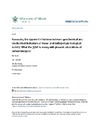Identificador persistente para citar o vincular este elemento:
https://accedacris.ulpgc.es/jspui/handle/10553/51638
| Título: | Assessing the apparent imbalance between geochemical and biochemical indicators of meso- and bathypelagic biological activity: What the @$#! is wrong with present calculations of carbon budgets? | Autores/as: | Burd, Adrian B. Hansell, Dennis A. Steinberg, Deborah K. Anderson, Thomas R. Arístegui, Javier Baltar, Federico Beaupré, Steven R. Buesseler, Ken O. DeHairs, Frank Jackson, George A. Kadko, David C. Koppelmann, Rolf Lampitt, Richard S. Nagata, Toshi Reinthaler, Thomas Robinson, Carol Robison, Bruce H. Tamburini, Christian Tanaka, Tsuneo |
Clasificación UNESCO: | 251001 Oceanografía biológica | Palabras clave: | Mesopelagic Bathypelagic Carbon budget Metabolic activity Carbon flux |
Fecha de publicación: | 2010 | Editor/a: | 0967-0645 | Proyectos: | Intercambio Plataforma-Oceano en El Ecosistema Marino de Las Islas Canarias-Peninsula Iberica (Caibex):Afloramiento de Cabo Guir | Publicación seriada: | Deep-Sea Research Part II: Topical Studies in Oceanography | Resumen: | Metabolic activity in the water column below the euphotic zone is ultimately fuelled by the vertical flux of organic material from the surface. Over time, the deep ocean is presumably at steady state, with sources and sinks balanced. But recently compiled global budgets and intensive local field studies suggest that estimates of metabolic activity in the dark ocean exceed the influx of organic substrates. This imbalance indicates either the existence of unaccounted sources of organic carbon or that metabolic activity in the dark ocean is being over-estimated. Budgets of organic carbon flux and metabolic activity in the dark ocean have uncertainties associated with environmental variability, measurement capabilities, conversion parameters, and processes that are not well sampled. We present these issues and quantify associated uncertainties where possible, using a Monte Carlo analysis of a published data set to determine the probability that the imbalance can be explained purely by uncertainties in measurements and conversion factors. A sensitivity analysis demonstrates that the bacterial growth efficiencies and assumed cell carbon contents have the greatest effects on the magnitude of the carbon imbalance. Two poorly quantified sources, lateral advection of particles and a population of slowly settling particles, are discussed as providing a means of closing regional carbon budgets. Finally, we make recommendations concerning future research directions to reduce important uncertainties and allow a better determination of the magnitude and causes of the unbalanced carbon budgets. | URI: | https://accedacris.ulpgc.es/handle/10553/51638 | ISSN: | 0967-0645 | DOI: | 10.1016/j.dsr2.2010.02.022 | Fuente: | Deep-Sea Research Part II: Topical Studies in Oceanography [ISSN 0967-0645], v. 57, p. 1557-1571 |
| Colección: | Artículos |
Citas SCOPUSTM
256
actualizado el 08-jun-2025
Citas de WEB OF SCIENCETM
Citations
243
actualizado el 08-jun-2025
Visitas
133
actualizado el 09-nov-2024
Descargas
255
actualizado el 09-nov-2024
Google ScholarTM
Verifica
Altmetric
Comparte
Exporta metadatos
Los elementos en ULPGC accedaCRIS están protegidos por derechos de autor con todos los derechos reservados, a menos que se indique lo contrario.
